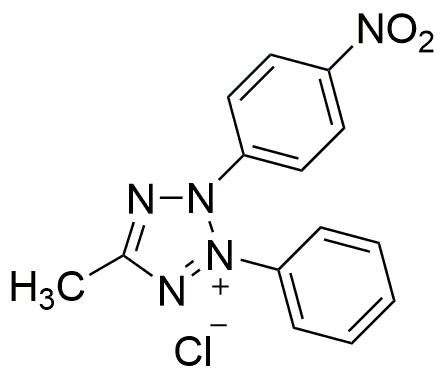3-(4-Nitrophenyl)-5-methyl-2-phenyltetrazolium chloride is widely utilized in research focused on:
- Cell Viability Assays: This compound is commonly used in MTT assays to evaluate cell proliferation and cytotoxicity, providing researchers with reliable data on drug efficacy.
- Biochemical Research: It serves as a colorimetric reagent for detecting metabolic activity in various biological samples, helping scientists understand cellular processes.
- Pharmaceutical Development: In drug formulation studies, it aids in assessing the effectiveness of new compounds against specific cell lines, streamlining the drug discovery process.
- Environmental Monitoring: The compound can be applied in studies assessing the impact of pollutants on microbial activity, offering insights into environmental health.
- Food Safety Testing: It is utilized in assays that determine the viability of microorganisms in food products, ensuring safety and compliance with health standards.
General Information
Properties
Safety and Regulations
Applications
3-(4-Nitrophenyl)-5-methyl-2-phenyltetrazolium chloride is widely utilized in research focused on:
- Cell Viability Assays: This compound is commonly used in MTT assays to evaluate cell proliferation and cytotoxicity, providing researchers with reliable data on drug efficacy.
- Biochemical Research: It serves as a colorimetric reagent for detecting metabolic activity in various biological samples, helping scientists understand cellular processes.
- Pharmaceutical Development: In drug formulation studies, it aids in assessing the effectiveness of new compounds against specific cell lines, streamlining the drug discovery process.
- Environmental Monitoring: The compound can be applied in studies assessing the impact of pollutants on microbial activity, offering insights into environmental health.
- Food Safety Testing: It is utilized in assays that determine the viability of microorganisms in food products, ensuring safety and compliance with health standards.
Documents
Safety Data Sheets (SDS)
The SDS provides comprehensive safety information on handling, storage, and disposal of the product.
Product Specification (PS)
The PS provides a comprehensive breakdown of the product’s properties, including chemical composition, physical state, purity, and storage requirements. It also details acceptable quality ranges and the product's intended applications.
Certificates of Analysis (COA)
Search for Certificates of Analysis (COA) by entering the products Lot Number. Lot and Batch Numbers can be found on a product’s label following the words ‘Lot’ or ‘Batch’.
Número de catálogo
Número de lote/lote
Certificates Of Origin (COO)
This COO confirms the country where the product was manufactured, and also details the materials and components used in it and whether it is derived from natural, synthetic, or other specific sources. This certificate may be required for customs, trade, and regulatory compliance.
Número de catálogo
Número de lote/lote
Safety Data Sheets (SDS)
The SDS provides comprehensive safety information on handling, storage, and disposal of the product.
DownloadProduct Specification (PS)
The PS provides a comprehensive breakdown of the product’s properties, including chemical composition, physical state, purity, and storage requirements. It also details acceptable quality ranges and the product's intended applications.
DownloadCertificates of Analysis (COA)
Search for Certificates of Analysis (COA) by entering the products Lot Number. Lot and Batch Numbers can be found on a product’s label following the words ‘Lot’ or ‘Batch’.
Número de catálogo
Número de lote/lote
Certificates Of Origin (COO)
This COO confirms the country where the product was manufactured, and also details the materials and components used in it and whether it is derived from natural, synthetic, or other specific sources. This certificate may be required for customs, trade, and regulatory compliance.


